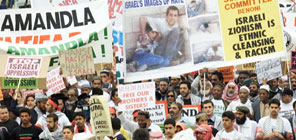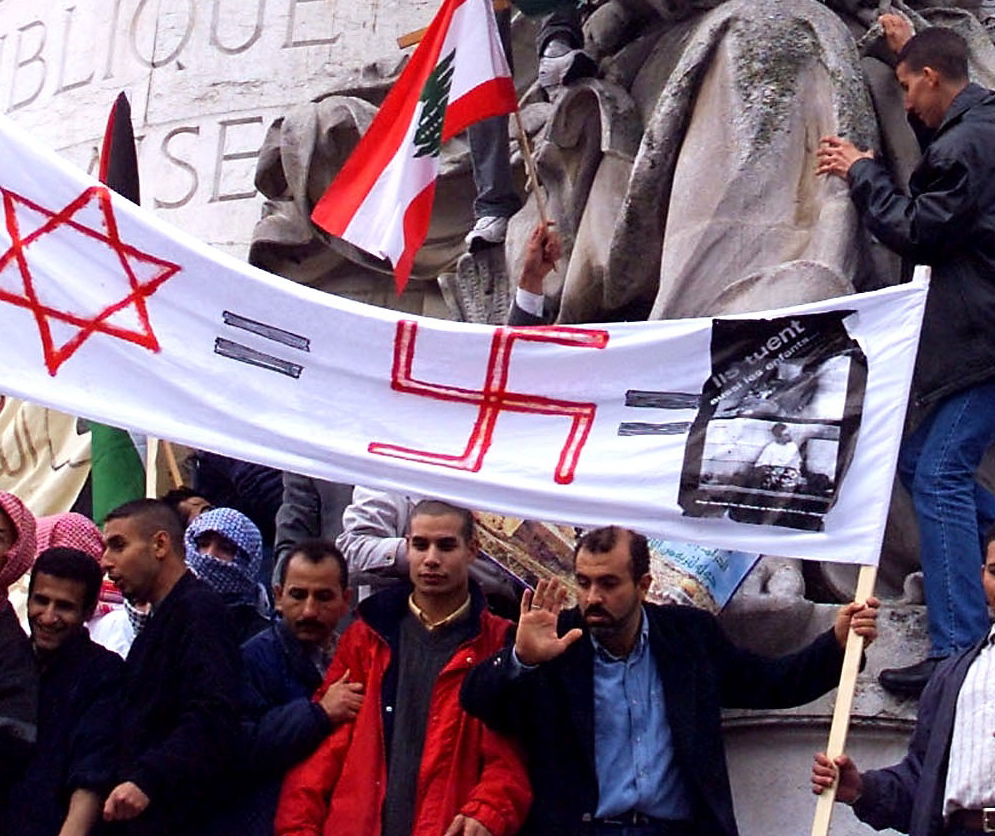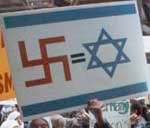Initial Responses
Western Responses
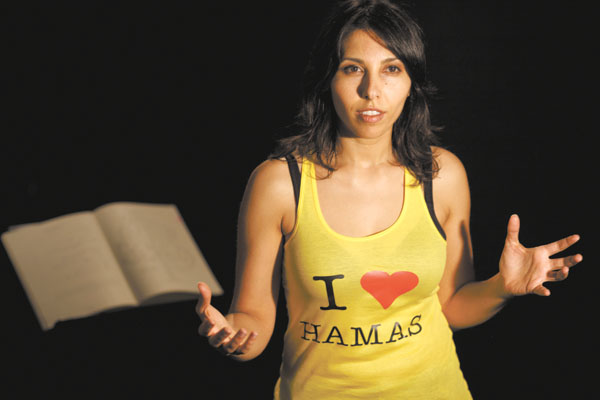
1. Talal’s narrative accepted without question
The first impact of al Durah on the West was the near total credulity of the media, the public, even public officials. Not only did the press present it as unquestionably real – with special warnings about the disturbing nature of the footage about to be shown – but in Europe, as in the Arab world, the footage was shown over and over as an illustration of the conflict. No non-Israeli correspondent questioned the news, and when CBS had a chance to let the public know some of the most telling doubts, they focused on the enraging settlements and dismissed the findings with “but the investigation had made up its mind before they fired the first shot.” So when Time Magazine prepared its “Man of the year” issue for year’s end, they had Muhamed as one of the “persons of the year.”
2. Tipping the political scales
The immediate impact of this footage produced a dramatic shifting of the political scales. Clinton was shocked, (as he described in “My Life“) Chirac publicly snubbed Barak four days later in Paris and lectured him on how killing Palestinian children was “no policy.” All the goodwill Barak had acquired in his offers at Camp David evaporated, and Arafat, according to one of his advisors, was returned to the world stage after his isolation for spoiling Camp David. People close to him described Arafat in the final months of 2000 as euphoric, thrilled with the romantic portrayal of the nascent intifada, and believing that the whole world supported him. Barak and Israel were now the outcasts.
3. Palestinian sources given broad credibility: The Dominance of Lethal Journalism in Middle East Reporting
Once the media had accepted the Palestinian version of al Durah, all subsequent claims went through much more easily. Indeed, the shock produced by al Durah allowed another, almost as heinous the Israelis shot the ambulance driver who came to get wounded father and sonaccusation to go through the same day – namely that. The subsequent claims of Palestinian sources about the number of injured and dead – especially children – are then reported as reliable in the western press, and form the basis for the figures which, in some papers like the Boston Globe, ended every article on the intifada for months – the number of Israeli and (much greater number) of Palestinian dead and wounded. Even Israeli organizations, like Btselem accepted the claims of Palestinian sources in most cases. Pallywood reigned supreme. The climax of the Western Press’ credulity of Pallywood reached its apex in April 2002 when the Palestinians claimed hundreds and thousands massacred in Jenin.
4. Intensifying virulent anti-Zionism, Mainstreaming Nazis Substitution Theology
As a result of this widespread acceptance of the Palestinian narrative of victimization, anti-Zionist discourse increased notably. Those most committed to a post-colonial paradigm that sees Israel as an imperialist, colonialist, intruder and the Palestinians as indigenous victims of Israeli aggression had found their icon – the innocent Palestinian and the cold-blooded Israeli killer. Sympathy not only for the cause of Palestinian national self-determination, but also for its most radical and violent “activists” including suicide bombers. For people like Ramsay Clark, founder of International A.N.S.W.E.R. the picture of al Durah is the modern equivalent of the Jewish boy being rounded up by Nazis;
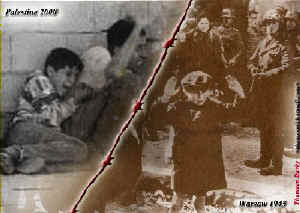 Nor was this just the rantings of a far-left group. Prominent mainstream journalist, Catherine Nay, anchorwoman at Europe1, said the same thing: “This death [sic] erases, replaces that of the boy in the Warsaw Ghetto.” In doing so she, and the many people whose thoughts she was expressing, used al Durah to effect a kind of substitution theology long advocated by the Palestinian camp, in which the Israelis were the new Nazis and the Palestinians the new Jews.
Nor was this just the rantings of a far-left group. Prominent mainstream journalist, Catherine Nay, anchorwoman at Europe1, said the same thing: “This death [sic] erases, replaces that of the boy in the Warsaw Ghetto.” In doing so she, and the many people whose thoughts she was expressing, used al Durah to effect a kind of substitution theology long advocated by the Palestinian camp, in which the Israelis were the new Nazis and the Palestinians the new Jews.
The increase in virulence of global anti-Zionism, presided over by the Western “left” became fully evident at Durban, South Africa, where a UN conference on racism (2001) got hi-jacked into an assault on Israel and the USA, with Jamal al Durah giving press conferences and his son, paraded in effigy through the streets.
Anti-Zionism and the “blood libels” associated with its most extreme forms (cans labeled “canned Palestinian children meat, slaughtered according to Jewish rites under American license,”) appeared in campuses all across Europe and even in the US.
5. Opening door to new levels of anti-Semitic literature and anti-Jewish activity
Since al Durah and the spiral of violence in the Middle East and the media’s widespread tendency to show Israel in the worst possible light, and particularly in the aftermath of the Jenin “massacre” reports, a whole range of previously “politically incorrect” comments about Israel and Jews became increasingly acceptable: from France’s ambassador to England calling Israel a “shitty little country” to comparisons with the Nazis, to mainstream publications carrying articles questioning Israel’s right to exist. British magazine New Statesman, which portrays itself as “the essential read for bright thinkers everywhere” had a front cover featuring a Star of David standing on a Union Jack above the headline `A Kosher Conspiracy’ in order to denounce the “pro-Israel lobby in the country”. The magazine soon clarified, however, that the cover was not intended to be ‘anti-Semitic.” These developments continue to grow apace, with a pro-suicide-terrorist play in Germany sponsored by the government, a vicious anti-Jewish poem included in a collection for British school children and a public display of anti-Semitic literature in the world’s most important event, the Frankfurt Book Fair. Accompanying this rise in verbal violence came a wave of attacks on Jews and Jewish sites, especially in Europe, that, beginning in October 2000 that spread globally, and, in addition to many places in the Muslim world, grew markedly in Europe for years afterwards.
Let us look at some of the most vicious Western anti-Israeli and anti-Jewish acts and statements in the post-al Durah affair world.
ISRAEL LIKE NAZIS RHETORIC:
Place de la République, October 6, 2000. French Muslims and Leftists demonstrate. “Cries of Death to the Jews” heard in a European capital for the first time since the Nazi period.
I have to wonder about people who compare Israelis to Nazis, I ask myself, why do they hate Israel, which is, after all, the Jewish state, so much? Elie Wiesel
• Portuguese Nobel laureate Jose Saramago compared the Israeli treatment of Palestinians in the West Bank to Auschwitz (March 2002) and later declared that the Jewish people no longer deserved sympathy for the Holocaust. (October 2003)
• Binghamton University (NY) professor James Petras defends Saramago’s remarks and argues for the validity of the analogy between Israeli and Nazi policies. (April 2002)
• Belgian parliamentarian says that Israelis are “making a concentration camp out of the West Bank.” (April 2002)
• Norman G. Finkelstein, professor of political science at DePaul University, writes that “if Israelis don’t want to stand accused of being Nazis they should simply stop acting like Nazis.” (April 2002)
• Irish Poet and Oxford academic Tom Paulin calls Jewish settlers “Nazis.”(April 2002)
• Michael Hoffman, a former reporter for the New York bureau of the Associated Press, publishes a book titled “The Israeli Holocaust Against the Palestinians.” (2002)
• Michael Neumann, a philosophy professor at Trent University in Peterborough, Ontario, in “Israelis and Indians” (2002) states that Jewish settlers want peace “just as Hitler wanted peace.”
• French anti-Globalization activist Jose Bove use of words ‘internment camps”, “watchtowers,” “roundups” to describe Israeli actions, implying a comparison with Nazism. (2002)
• In Greece, mainstream media references to Auschwitz, Mauthausen and Dachau are often made in cartoons depicting Israeli soldiers as Nazi soldiers.
• Welsh politician compares Israel unfavorably to Nazi Germany. To him: “Hitler’s Nazi regime occupied Europe for four years only. Palestine and the West Bank have been occupied for 40 years.” (January 2003)
• Greta Duisenberg, Dutch, wife of the European Central Bank (ECB) chief Wim Duisenberg, called Israeli policies in Gaza and the West Bank as “worse than the Nazi rule in Holland.” (January 2003)
• In an article in French newspaper “Le Monde” titled “Israel, Palestine: The Cancer” the authors wrote that Jews, a “dominating and self-assured people” who are “behaving as a superior race” and who “were the victims of a pitiless order are imposing their pitiless order on the Palestinians. The Jewish victims of inhumanity are displaying a terrible inhumanity.” (June 2002)
• Antiwar rallies in the West feature flags and posters that equate Israel and Jews with Nazi Germany.
• British MP compares the situation in Gaza to the Warsaw ghetto. (June 2003)
• Portuguese commentator Sousa Tavares wrote in newspaper PÚBLICO that: “If there is a World War III, it will be because of Israel … and of its attempt to solve the Palestinian problem, not through any peace accord, but through, you have to excuse me, a ‘final solution’ – the political, civic and, if necessary, human extermination of Palestinians.” (November 2003)
• Italian survey found that close to 40 percent of respondents agreed with the statement that “the Israeli government is perpetrating a full-fledged genocide and is acting with the Palestinians the way the Nazis did with the Jews.” (January 2004)
• Irish Nobel Peace Prize laureate Mairead Corrigan Maguire compared Israel’s nuclear arsenal to Hitler’s gas chambers. (December 2004)
• The Young Women’s Christian Association (YWCA) 2004 Witness Report concluded that Israelis were trying to “rid the land of Palestinians” just as “Hitler tried to exterminate the Jews.”
• German survey reveals that 51% of Germans believe that Israel’s present-day treatment of the Palestinians is equivalent to the Nazi atrocities against European Jews during World War II. (December 2004)
• Anthony Lipmann, in a comment piece in The Spectator (UK) compares the battle for Jenin to Auschwitz. (January 2005)
• Ken Livingstone, mayor of London, compares Jewish reporter to “concentration camp guard.” (February 2005)
• Pro-Palestinian activist Rachel Corrie is compared to Anne Frank (April 2005).
• Review of Jacqueline Rose book “The Question of Zion,” (2005) who compares Israeli treatment of Palestinians to German treatment of Jews.
ARTICLES/BOOKS THAT REFER TO THE RISE OF ANTI-SEMITISM IN EUROPE AND/OR ANTI-ISRAEL SENTIMENT:
• “Europe Knows who’s to Blame in the Middle East,” by Steven Erlanger, New York Times, (April 2002)
• Paul Berman’s article, “Bigotry in Print. Crowds Chant Murder. Something’s Changed” (May 2002) about intellectual anti-Semitism in the European press and how “It is not so easy to put up a fight against a wind, a tone against an indefinable spirit of hatred that has begun to appear even in the statements of otherwise sensible people.”
• New York Times Columnist Thomas Friedman writes in “Nine Wars Too Many” (May 2002): “The anti-Semitism coming out of Europe today suggests that deep down some Europeans want a lot more: They want Mr. Sharon to commit a massacre against Palestinians, or they want to describe what he did in Jenin as a massacre, so that the Europeans can finally get the guilt of the Holocaust off their backs and be able to shout: “Look at these Jews, they’re worse than we were!”
• In a similar vein, Poet Bernard Horn, in “Judgment” writes that Europeans compare Jews to Nazis in order to “be free of the burden of judgment forever.” “And so Europe said,” he adds, “‘Let the Jews be Nazis.'” If the Jews are Nazis there is no longer anything to feel guilty about. If the Jews are Nazis there is no Holocaust. And Europe said, “‘Let the Jews be Nazis. And let judgment cease.'”
• “How Bad Is It?” by James Geary, Time magazine (June 2002)
• French scholar Pierre André Taguieff sees “La Nouvelle Judéophobie” (2002) (The New Judeophobia), based no longer primarily on race but on a religious and geopolitical dimension, as an essential part of Islamic terrorism.
• Avi Becker article “Anti-Semitism in the guise of intellectualism” (October 2002). To him: “The new anti-Semitism eclipses reason and morality, obfuscating concepts. The unholy alliance between European leftists whose ranks include academics and intellectuals, and fundamentalists and Islamic terror, endangers Israel and the Jews, and threatens the moral strength of Western culture.”
• In “The New Anti-Semitism” (2003) Phyllis Chesler uses the word ‘European Intifada’ to describe “the uprising and attack against Diaspora Jews in Europe and North America.” To her, “Jews are being attacked outside of Israel in retaliation for Israel’s continued existence and as part of a general propaganda-driven resurgence of anti-Semitism.” (P.120)
• “Mutating Virus: Hatred of Jews” By Edward Rothstein, New York Times (May 2003)
• Marie Brenner, “France’s Scarlet Letter” from “Those Who Forget The Past: The Question of Anti-Semitism,” (2004)
• Robert S. Wistrich, in “Cruel Britannia“, Azure journal, (Summer 2005) argues that “While many European countries have come to associate anti-Semitism with the forces of either the extreme Right, radical Left, or the increasingly vocal Muslim minorities, in Britain anti-Semitic sentiment is a part of mainstream discourse, continually resurfacing among the academic, political, and media elites.”
• Josef Joffe “An Old Evil Raises Its Weary Head“, Time magazine (November 9, 2003)
• EU survey finds that a majority of Europeans believe Israel is the biggest threat to world peace. (November 2003)
• “What’s causing the Anti-Semitic Attacks?” James Graff, Time Magazine (November 2003)
• “The Scourge Unleashed” By Stuart Schoffman (December 2003)
• Manfred Gerstenfeld “Anti-Semitism: An Integral Part of European Culture” (March 30, 2004)
• 2004 Haaretz discussion on the phenomenon of “new anti-Semitism” in Europe.
• Robert S. Wistrich, in “Cruel Britannia“, Azure journal, (Summer 2005) argues that “While many European countries have come to associate anti-Semitism with the forces of either the extreme Right, radical Left, or the increasingly vocal Muslim minorities, in Britain anti-Semitic sentiment is a part of mainstream discourse, continually resurfacing among the academic, political, and media elites.”
• Anti-Defamation League European survey (2005) finds that anti-Semitic attitudes are still strongly held and a majority say that their opinion of Jews is worse as a result of actions taken by Israel.
RISE OF ANTI-SEMITIC ATTACKS IN EUROPE:
• REPORT BY EUROPEAN MONITORING CENTRE ON RACISM AND XENOPHOBIA (2002) shows an increase of anti-Semitic activities since the escalation of the Middle East conflict in 2000.
• REPORT BY EUROPEAN MONITORING CENTRE ON RACISM AND XENOPHOBIA (2004)
• US Department of State Report on Global anti-Semitism (2005) found an increase in European anti-Semitic attacks.
• BRITAIN
• GERMANY
• GREECE
• FRANCE
• BELGIUM
• SWEDEN
• “The Reflowering of anti-Semitism” By Seth Gitell, The Boston Phoenix, (July 2002)
• “Liberté, Egalité, Judéophobie” by Christopher Caldwell, The Weekly Standard, May 2002.
• “A Frenchman Or a Jew?” By Fernanda Eberstadt, The New York Times Magazine, February 2004.
All of this begs one final Question about the double standard in reporting the intifada:
Why is israel held to a higher standard than the Palestinians? Could it be because of the soft bigotry of low expectations? This unbalanced view has consequences: it distorts Western public opinion, leads to demonizing israel and romanticizing the Palestinians. In her book “The Other War” (2005) Stephanie Gutmann describes her meeting with a senior BBC producer in the following manner:
“‘You must be able to see that you have a rather dramatic lean in one direction,’ I said … ‘It’s like Israel is under a microscope – everything exposed, everything subject to criticism – but their failings are not balanced by anything on the other side. And we all know terrible things are happening on the other side, don’t we?’ I said, searching his face for some clue that he knew what I was talking about. He nodded. ‘It’s like you hold Israel to a higher standard than the Palestinians,’ I pressed. ‘I guess we do hold Israel to a higher standard,’ he mused. After all, it’s a Western country, a modern country …’ ‘ Isn’t it a little condescending not to hold the Palestinian Authority government to any sort of standard, as if they’re a bunch of primitives, or as if they’re children?’ I asked. ‘Interesting idea,’ he said, with what may have been forced heartiness. ‘I will have to give that some thought.'” (P.190)
When confronting this common response to the Israeli complaint of being held to a higher standard, Ben-Dror Yemini responds, “Pretend the woman next to you is Fatima. If you say you hold me to a higher standard, that means you hold her to a lower standard. Ask her how she feels about that?” Alas, for Palestinian demopaths, that’s just fine with them.


